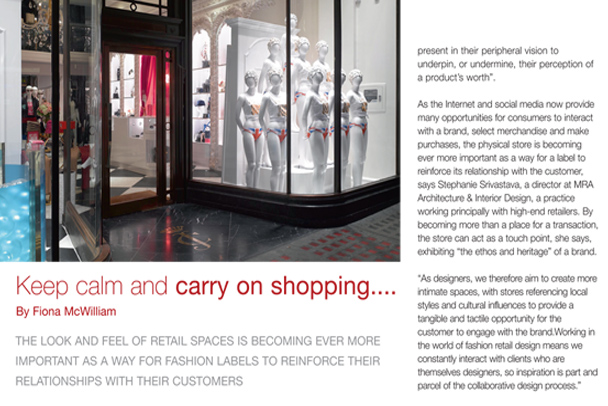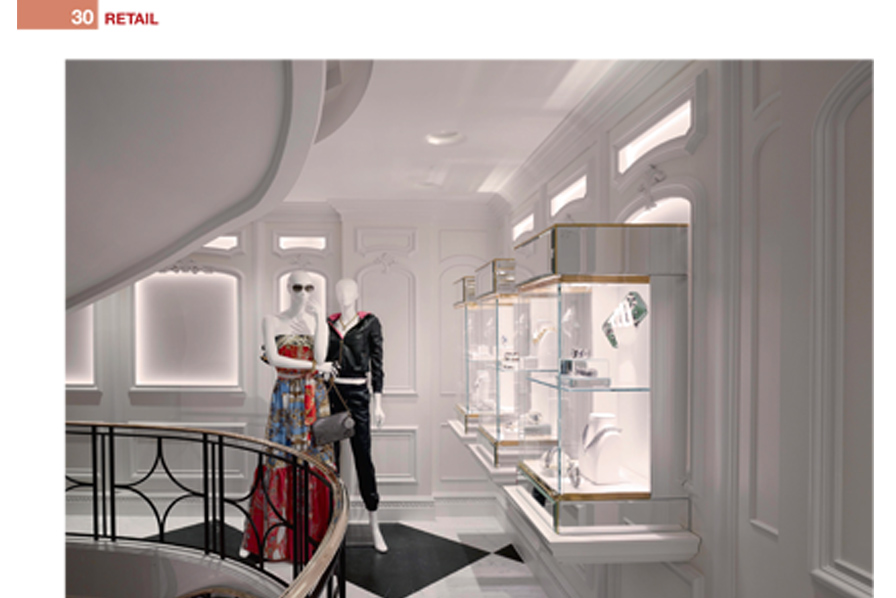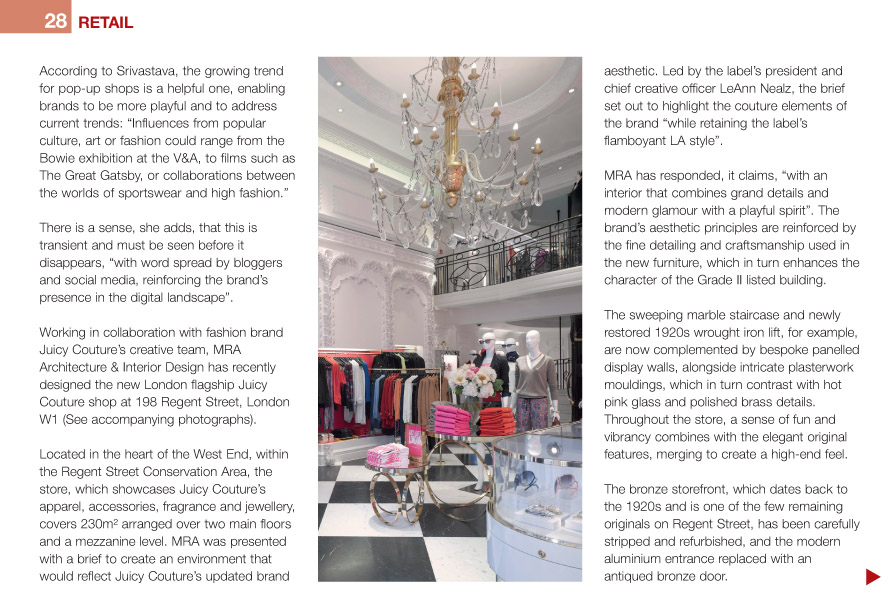Specification Magazine - MRA & The Future of Retail Design



21/06/2013
Categories:
MRA speaks to Specification Magazine (May 2013) about the future of retail design and the new Juicy Couture flagship store at 198 Regent Street., London W1. In the article MRA Director, Stephanie Srivastava, talks about the creation of good retail environments, the growing trend for collaboration and transience, and the connection with social media and the digital landscape. Here is the full article by Fiona McWilliam: Successful retailers, be they independent or corporate, high-end or mass market, accept that the creation
of a good retail environment is an essential part of their business plan. Such commitment, according to interior design expert Drew Plunkett and interior architect Olga Reid, owes everything to the objective evidence, consistently demonstrated in sales returns, of the positive impact of the right interior on sales. In their recent book Detail in Contemporary Retail Design (published by Laurence King, 2012) Plunkett and Reid note how retail interiors should “inspire, persuade and reassure”. The exterior of a shop and the building that contains its are, they write, only registered briefly, if at all, and the niceties of their construction are of little significance to those who pass inside. Once inside, however, “customers are unavoidably in intimate proximity to the materials and the construction details that have redefined the walls, floor, ceiling and the objects contained within them”. Qualities of detailing may only register subliminally, Plunkett and Reid note, but, “while customers focus on merchandise, the small-scale details of the building fabric are present in their peripheral vision to underpin, or undermine, their perception of a product’s worth”. As the Internet and social media now provide many opportunities for consumers to interact with a brand, select merchandise and make purchases, the physical store is becoming ever more important as a way for a label to reinforce its relationship with the customer, says Stephanie Srivastava, a director at MRA Architecture & Interior Design, a practice working principally with high-end retailers. By becoming more than a place for a transaction, the store can act as a touch point, she says, exhibiting “the ethos and heritage” of a brand. “As designers, we therefore aim to create more intimate spaces, with stores referencing local styles and cultural influences to provide a tangible and tactile opportunity for the customer to engage with the brand.Working in the world of fashion retail design means we constantly interact with clients who are themselves designers, so inspiration is part and parcel of the collaborative design process.” It is important, Srivastava adds, that a store retains the brand's signature, while avoiding the “roll out” feel. “This requires bespoke design and careful detailing to give, for example, the sense that furniture or lighting has been crafted rather than mass-produced, and could mean the sourcing and up-cycling of vintage furniture, or hand cast plaster mouldings. The emphasis is on quality rather than quick fashion fixes, reflecting what the customer expects from their purchase.” According to Srivastava, the growing trend for pop-up shops is a helpful one, enabling brands to be more playful and to address current trends: “Influences from popular culture, art or fashion could range from the Bowie exhibition at the V&A, to films such as The Great Gatsby, or collaborations between the worlds of sportswear and high fashion.” There is a sense, she adds, that this is transient and must be seen before it disappears, “with word spread by bloggers and social media, reinforcing the brand’s presence in the digital landscape”. Working in collaboration with fashion brand Juicy Couture’s creative team, MRA Architecture & Interior Design has recently designed the new London flagship Juicy Couture shop at 198 Regent Street, London W1 (See accompanying photographs). Located in the heart of the West End, within the Regent Street Conservation Area, the store, which showcases Juicy Couture’s apparel, accessories, fragrance and jewellery, covers 230m2 arranged over two main floors and a mezzanine level. MRA was presented with a brief to create an environment that would reflect Juicy Couture’s updated brand aesthetic. Led by the label’s president and chief creative officer LeAnn Nealz, the brief set out to highlight the couture elements of the brand “while retaining the label’s flamboyant LA style”. MRA has responded, it claims, “with an interior that combines grand details and modern glamour with a playful spirit”. The brand’s aesthetic principles are reinforced by the fine detailing and craftsmanship used in the new furniture, which in turn enhances the character of the Grade II listed building. The sweeping marble staircase and newly restored 1920s wrought iron lift, for example, are now complemented by bespoke panelled display walls, alongside intricate plasterwork mouldings, which in turn contrast with hot pink glass and polished brass details. Throughout the store, a sense of fun and vibrancy combines with the elegant original features, merging to create a high-end feel. The bronze storefront, which dates back to the 1920s and is one of the few remaining originals on Regent Street, has been carefully stripped and refurbished, and the modern aluminium entrance replaced with an antiqued bronze door. The vestibule features a brass Juicy Couture logo inlaid into marble flooring. From here, visitors enter the main retail space and are greeted with a highly decorative environment where a striking Italian marble chequerboard floor and over-sized furniture are designed to give the impression of a lavish entrance hall to a luxurious salon. This feeling is reinforced by a chandelier designed specifically for the Regent Street store and generously scaled to suit the double-height space. Encircling the decorative fitting, an oval handmade plaster ring (a contemporary take on the ceiling rose) serves to house modern lighting. The cash/wrap desk, with glazed display vitrines, is designed to evoke a traditional store counter. Behind the desk, a feature wall with ornate full-height plaster palm trees and a theatrical pink taffeta curtain creates a backdrop for a neon Juicy Couture logo. The palm trees, for which the Regent Street store marks a debut, were developed by the Juicy Couture creative team and manufactured in California. Bespoke brass and mirror tables and shelves showcase smaller accessories and, around the staircase, jewellery is displayed in mirrored vitrines. The stairs lead up to the mezzanine level, where Juicy Couture’s Bird clothing collection is displayed on simple, elegant brass rails. A discreet glass balustrade overlooks the double-height ground-floor space, bringing the existing metalwork handrail to modern standards without compromising its appearance. The basement retail floor features a library- inspired display of Juicy Couture’s iconic velour tracksuits. Consistent features connect this
space with the ground floor, with decorative mouldings and cream panelled walls – “feminine detailing that lends elegance and contrasts with the vibrant colour of the clothing”. The main feature of this floor is an illuminated pink glass screen. The parquet floor adds warmth as well as emphasising the marble-topped display table, cut from the same stone as the flooring on the floor above. All photographs, of Juicy Couture's new flagship London store, by Nick Guttridge